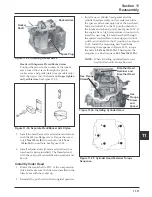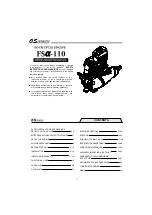
10.5
Section 10
Internal Components
10
Figure 10-4. Standard Valve Seat Cutter.
Lapping Valves
Reground or new valves must be lapped in, to provide
fit. Lightly coat valve face with
fine
grade of grinding
compound. Use a hand valve grinder with suction
cup for final lapping. Clean and dry cylinder head
and apply a light coating of
SAE 10
oil to prevent
rusting.
Intake Valve Stem Seal
These engines use valve stem seals on the intake
valves. Always use a new seal when valves are
removed from cylinder head. The seals should also be
replaced if deteriorated or damaged.
Never reuse an
old seal.
Pistons and Rings
Inspection
Scuffing and scoring of pistons and cylinder walls
occurs when internal temperatures approach the
welding point of the piston, usually attributed to
improper lubrication, and/or overheating of the
engine.
Normally, very little wear takes place in the piston
boss-piston pin area. If the original piston and
connecting rod can be reused after new rings are
installed, the original pin can also be reused but new
piston pin retainers are required. The piston pin is
included as part of the piston assembly - if the pin
boss or the pin are worn or damaged, a new piston
assembly is required.
Ring failure is usually indicated by excessive oil
consumption and blue exhaust smoke. When rings
fail, oil is allowed to enter the combustion chamber
where it is burned along with the fuel. High oil
consumption can also occur when the piston ring end
gap is incorrect. Oil control is also lost when ring gaps
are not staggered during installation.
When cylinder temperatures get too high, lacquer and
varnish collect on pistons causing rings to stick which
results in rapid wear. A worn ring usually takes on a
shiny or bright appearance.
Scratches on rings and pistons are caused by abrasive
material such as carbon, dirt, or pieces of hard metal.
Detonation damage occurs when a portion of the fuel
charge ignites spontaneously from heat and pressure
shortly after ignition. This creates two flame fronts
which meet and explode to create extreme hammering
pressures on a specific area of the piston. Detonation
generally occurs from using fuels with low octane.
Preignition or ignition of the fuel charge before the
timed spark can cause damage similar to detonation.
Preignition damage is often more severe than
detonation damage - often a hole is quickly burned
right through the piston dome. Preignition is caused
by a hot spot in the combustion chamber from sources
such as: glowing carbon deposits, blocked fins,
improperly seated valve, or wrong spark plug.
See Figure 10-5 for some common types of piston and
ring damage.
Valve Seat Cutter
Pilot
Valve Seat Inserts
Intake valve seats are usually machined into the
cylinder head, however, certain applications may
specify hard alloy inserts. The valve seats are not
replaceable. If cracked or badly warped, the cylinder
head should be replaced.
Use a standard valve seat cutter (see Figure 10-4) and
cut seat to dimensions shown in Figure 10-3 (valve
details illustration).
















































